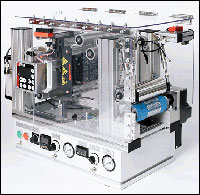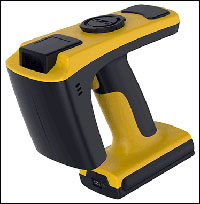The following are news announcements made during the past week by the following organizations:
Voyantic;
Technology Solutions (UK) Ltd.;
Junmp;
SenseStone; and
Mikron.
Voyantic System Measures Effects of Repeatedly Bending a Tag
Voyantic Ltd., a provider of RFID measurement solutions based in Finland, has announced Bendurance, a testing system designed to analyze the changes induced to ultrahigh-frequency (UHF) RFID tags’ operation sensitivity due to repeated bending.
With Bendurance, the tag samples are stressed by running them in a loop through a set of bending rollers, and their performance is then evaluated via Voyantic’s Tagsurance ultrahigh-frequency (UHF) production testing system (which can detect and flag UHF tags that do not meet their specified characteristics), using communication tests at several frequency and power-level combinations. In addition to bending, the samples may also be subjected to compression stress during the run.
The Bendurance system operates in multiple motion and test modes, according to Voyantic. Tags can be stressed in continuous motion, and can be monitored constantly at a chosen frequency. A more thorough analysis can be performed at intervals, by stopping the continuous stress after a set amount of rounds and then running performance tests. The test results are logged into a data file, to be handled later for statistical analysis purposes. The threshold sweep results can be analyzed post-test using a separate software tool known as Tagsurance Sweep Data Analyzer.
Voyantic is showcasing its RFID test and measurement solutions in booth 810 at this week’s RFID Journal LIVE! conference and exhibition, being held in San Diego, Calif.
Technology Solutions (UK) Ltd. Introduces Bluetooth Rugged UHF RFID Reader
Technology Solutions (UK) Ltd. (TSL) has announced its 1166 Bluetooth Rugged UHF RFID Reader, a new addition to TSL’s portfolio of mobile ultrahigh-frequency (UHF) readers. The 1166 reader features an extra-tough form factor, has an IP 68 rating (meaning it is waterproof and dustproof) and has a 2-meter (6.6-foot) drop specification. A high-capacity battery enables up to 20 hours of run time, the company reports.
The device is compatible with Bluetooth-enabled host devices and delivers UHF RFID and 2D bar-code-scanning capabilities to handhelds, smartphones, touchscreen MP3 players, tablets and PCs running a wide range of operating systems. Software support is available for a range of platforms, according to TSL, including code samples, demonstration applications and source code.
The new 1166 Rugged Bluetooth UHF RFID Reader incorporates TSL’s ASCII protocol, which is designed to enable faster and easier application development, the company reports. This ASCII protocol provides users with a powerful set of commands that carry out multiple actions locally within the reader, according to TSL. This approach enables multiple tag operations executed using simple pre-configured ASCII commands, which not only speeds up integration of the reader into applications, but also abstracts the developer from some of the complexities of the underlying native application programming interface (API), and ultimately results in what the company describes as unparalleled levels of performance.
TSL is demonstrating its products in booth 119 at this week’s RFID Journal LIVE! conference and exhibition in San Diego.
Junmp Announces Switch-augmented RFID Tag
Junmp has announced its development of a new type of switch-augmented RFID tag that, according to the company, is suitable for tracking and checking bags of valued items. The tag leverages Impinj‘s Monza X RFID chip, which enables I2C wireless communication with processors inside electronic devices. The new Junmp tag features dual interfaces: a wireless ultrahigh-frequency (UHF) interface for communication with standard EPC Class 1 Gen 2 readers, and a wired I2C interface managed by a microcontroller for receiving instructions to control the tag’s on-off switch operations.
The tag measures 86 millimeters by 105 millimeters by 23 millimeters (3.39 inches by 4.13 inches by 0.91 inch), and features an acrylonitrile butadiene styrene (ABS) housing affixed via screws. It has 128 bits of Electronic Product Code (EPC) memory and a read range of 1 to 12 meters (3.3 to 39.4 feet), depending on the reader type and environment. The new tag can operate in temperatures ranging from -20 degrees to +85 degrees Celsius (-4 degrees to +185 degrees Fahrenheit) with 85 percent relative humidity.
Junmp is exhibiting its products in booth 730 at this week’s RFID Journal LIVE! conference and exhibition, being held in San Diego, Calif.
SenseStone Introduces Ultra-Small RFID tags
SenseStone Technologies Co. Ltd., a manufacturer of ultrahigh-frequency (UHF) ceramic and metal tags, has announced a family of ultra-small metal tags with updated temperature resistance and easier installation. , According to SenseStone, the tags, which range from 4 millimeters by 4 millimeters by 3 millimeters (0.2 inch by 0.1 inch by 0.1 inch) to 10 millimeters by 1.8 millimeters by 1.8 millimeters (0.4 inch by 0.07 inch by 0.07 inch) in size, are suitable for tracking small tools and IT assets.
The tags are resistant to temperatures of up to 220 degrees to 250 degrees Celsius (428 degrees to 482 degrees Fahrenheit), SenseStone reports, and can be embedded into screws, clamps and plates in order to meet various applications requirements.
SenseStone is exhibiting its products in booth 250 at this week’s RFID Journal LIVE! conference and exhibition, in San Diego.
Mikron Unveils Two New HF RFID Chips
Mikron, a Russian manufacturer of microelectronics, has unveiled two non-volatile memory (NVM) high-frequency (HF) 13.56 MHz RFID chips. Both are compliant with the ISO 14443A specification and are suitable for transport, event-ticketing, access-control, gaming and identity applications.
The MIK640M2D has a read range of up to 100 millimeters (3.4 inches), depending on the inlay antenna and reader used. Its anti-collision function allows the reader to quickly communicate with more than one ISO14443 card placed in the field, and the anti-collision algorithm enables the selection of each card individually, eliminating any interference from another card placed in the field during exchange. The IC’s security includes an individual 7-byte unique identifier (UID) programmed into every transponder IC at the factory. It cannot be reprogrammed by the user, Mikron reports, and is an effective way to protect transponder ICs from forgery. The UID can be used to cryptographically protect data in the transponder ICs memory. The IC features 32-bit and 128-bit one-time programmable (OTP) areas that are provided for single, irreversible write operations. There is also a programmable write protection function for EEPROM pages, with decimal numbers 3-15—for example, for a 32-bit OTP area—that enables read-only data on these pages.
The MIK213ND NFC chip features the same anti-collision functions as the MIK640M2D, but there are additional security features. An individual 7-byte UID is programmed into every transponder IC, while a 32-bit OTP area is provided for a single irreversible write operation. In addition, there is a 16-bit counter (IC mode 0) for incrementing by any positive value, and a 24-bit counter (IC mode 1) for incrementing by 1 after read operations. The transponder IC does not allow a reduction in counter value or incrementing that leads to exceeding the maximum counter value (for 24-bit counter 16777215 in decimal, FFFFFFh in hex; and for 16-bit counter 65535 in decimal, FFFFh in hex). The IC also contains a 32-byte elliptic curve cryptography (ECC) signature for protection from forgery. The IC provides optional password data protection (only in IC mode 1) that can be set by a card user, and it is also possible to limit the number of unsuccessful authentication attempts.
Mikron is showcasing its products in booth 448 at this week’s RFID Journal LIVE! conference and exhibition in San Diego.



